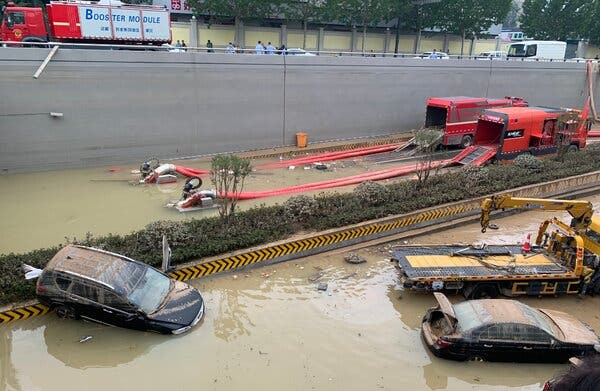Before I start. I’ve said it before and I’ll say it again, I don’t care whether you call it Global Warming or Climate Change I just want something done about it!

Over the last week there have been two very similar stories from nearly opposite ends of the Earth. The first story concerned a series of very heavy storms that produced a record setting amount of rain in the city of Zhengzhou in central China. At its peak on July 22, the rain fell at a rate of over 20cm per hour and theoretically the total amount that fell on Zhengzhou and the surrounding region was equivalent to a one-in-a-thousand-years rain event for the city and region. That statistical estimate was before global warming of course.

The flooding caused extensive damage throughout the city but the worst incidences occurred in the city’s subway and highway tunnels. The torrent of water falling onto paved roads and concrete sidewalks flowed into the underground passages filling them up like a bathtub. Thousands of commuters who were inside the city’s subway became trapped, some of them forced to stand in chest deep water for hours while at least 13 people drowned. In another part of Zhengzhou a new highway tunnel was flooded with more than 200 cars trapped inside. Four people are known to have died in the highway tunnel but the toll there could have been much worse if not for the bravery of a retired member of the Chinese army’s elite commandos named Yang Junkui. Mister Yang became a hero by swimming from car to car rescuing the trapped occupants.

Both of the underground systems in Zhengzhou were constructed with a pumping system installed that was designed to handle the amount of rainfall expected in a once in 50-year storm. The rain that fell on the city that day simply overwhelmed those pumps however. Even after the storms had passed additional pumping equipment had to be brought in to help clean up both tunnel networks.

Only two days after the deluge that crippled Zhengzhou another extreme weather system dropped 6-9 cm of rain per hour on the city of London in the UK causing flash floods and significant damage throughout the city. Once again the worst flooding occurred in the famed ‘London Underground’ subway system where several stations were forced to close.

Fortunately the heavy flooding that struck London, although destructive did not cause any loss of life. As I was reading these stories it occurred to me that a large part of our transportation infrastructure, like the London Underground, was constructed a long time before climate change became an issue. And even those systems that have been built more recently, like the Zhenghou highway tunnel, are not being built to deal with the extreme weather that is predicted to happen over the next few decades.

Cities bring these problems on themselves by paving over large areas of ground so that the rainwater cannot sink in. Instead the runoff overwhelms the drainage systems and accumulates in low-lying locations like subway or highway tunnels. My own hometown of Philadelphia is a prime example of these potential problems with the center of the city crisscrossed by the Market and Broad Street subways. Both of these systems are over one hundred years old and have many times in the past dealt with flooding issues. The likelihood of a catastrophic flooding event occurring sometime in the near future has to be taken seriously.

What if, thanks to global warming, one in a thousand year weather events start happening every fifty years or every thirty years? Can our subway systems and underground highway tunnels cope with the enormous rainfall totals to come or will disasters like Zhengzhou just become another ‘new normal’ like the wildfires breaking out now in Spain, Greece and Sardinia.

Between the wildfires, the floods, the sea level rise and droughts it sounds like the new normal is going to be one big long disaster.
